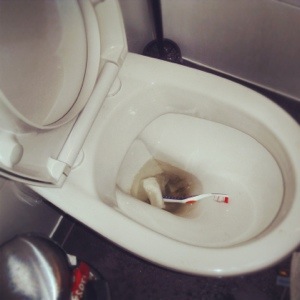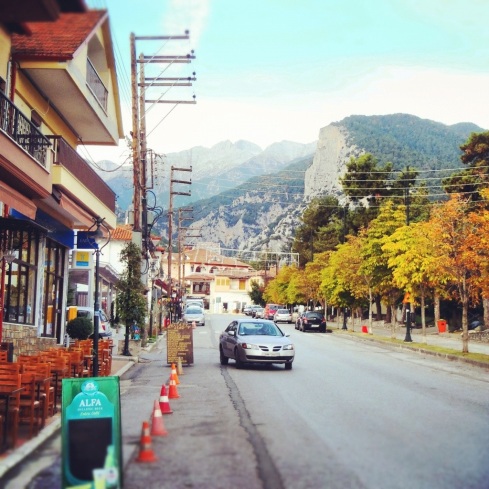SENDAR reached down and gently lifted the stray from its makeshift cocoon of white hessian under an old table by the roadside. The wide-eyed chocolate-coloured tabby almost fitted inside his curved palm. Her mother had died giving birth and she was the only surviving kitten of the litter, he said. When the snow came, she would be allowed inside the hostel.
On the third day of our stay at the bottom of the steepest road in Istanbul, Sendar told us he had named the kitten Gül, the Turkish word for Rose.

The collective care of animals, mainly stray cats in Istanbul was one of the first things that struck us as unique about the Turkish capital. With no RSPCA or similar, there are a lot, and I mean a lot of stray cats around. They are freaking everywhere, which was lucky for me, because I am a crazy cat lady.
A pounce of cats?

Brothers – Near Arasta Bazaar, Sultanahmet.

Coming from a media background in Australia, animal cruelty charge statements made a fairly regular appearance in my email inbox, so it was surprising, in a country lambasted for its slaughtering methods last year when activist group Animals Australia released video footage of the mistreatment of Australian live export sheep at Turkish abattoirs, to see an old man breaking off parts of his sandwich to feed to a cat hovering around his feet outside a cafe.
It was equally surprising to see small home made shelters littered along the city’s notoriously winding alleyways with cats lazing in or in top of them to catch a couple of hours of sun, and even more so to watch a fishmonger throw a small fish to a black and white cat that had been eyeing off his day’s live catch, before reaching up and feeding two huge seagulls that had settled on the red awning of his stall at the bustling Karakoy fish market.
Street shelters.

A scene from Karakoy fish market.
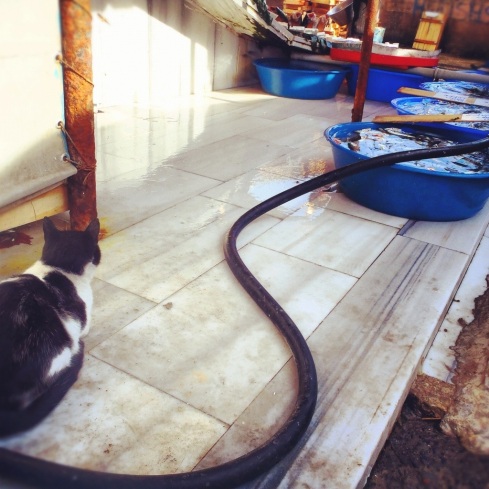

The seagulls’ rooftop vigil paid off – they were fed by a fishmonger moments after this photo was taken.

But Istanbul was just full of surprises for us.
Traversing three countries by rail and road, Nic and I stepped off the third bus of a 22 hour journey to Turkey at dusk, finding ourselves at the foot of Istanbul’s most famous road and in the midst of a pulsating crowd of two million people celebrating Eid al-Adha (Feast of the Sacrifice).
I suppose we should have realised something was going on in town when our bus crossed the Bulgarian border into Turkey passing hundreds of commercial trucks backed up for about 6 kilometres. (Check out the video we took!) We had set down in one of the world’s most populated cities at the beginning of a major Islamic holiday, followed directly by Turkish Republic Day.
The start of Istiklal Caddesi near Taksim Square.

From the subdued hum of weary travellers chatting quietly on the bus, we were thrown headfirst into the myriad of lights, sounds and smells that is Istiklal Avenue.
Kebab cooks in dirtied white aprons called out to us as we squeezed past their gaudily lit shops, laden with 18 kilogram conspicuous backpacks, to enter the main vein of the street. The crowd resembled giant schools of fish guided by invisible currents. Pairs of inebriated men with linked arms stumbled past street vendors spruiking mussels, sizzling chestnuts and pretzel-like bread rings. Families and groups of women in various degrees of hijab moved in tight groups, halting occasionally to look in clothing and sweet-shop windows. A bright red tram periodically parted the masses as it rattled past, gathering barnacles, or numerous young boys who jumped aboard to hang off its back and sides. Yellow taxis, heavily scratched and dented, beeped loudly, nudging their way out of side streets. Before we disappeared down one such alleyway, we soaked up fleeting loud moments of bass-filled dance music from second floor clubs.
From the very beginning, we were in awe of the spectacular energy of Istanbul. Already accommodating a massive 3 million people per day on a regular basis, hostel owner Sendar later told us that during the holiday, up to two million people filled Istiklal Avenue during any one moment.
Istiklal Caddesi.

Slipping away down Bogazkesen Avenue to our hostel, Cheers Midtown, we found it was a narrow, undulating road on a steep downhill slope, running almost all the way to the Galata Bridge, which connects the cities two major commercial and tourist districts, Taksim and Sultanahmet, and the Asian and European continents, over the Bosphorous Strait. Closer inspection of our surroundings revealed a ramshackle of convenience stores, a book shop, trendy bars, clothing boutiques, cafe’s, barber shops, bakeries and even homes – from various eras and in various stages of disrepair. A steady stream of taxis shot up the road and a woman stood in the shadows waiting for something or someone. She held the end of a rope that was tied around the neck of a thin sheep laying on the footpath. We later realised the animal was to be sacrificed in religious ritual.
Bogazkasen Caddesi.

We arrived at the hostel late, but gracious host Sendar put us up in a better room than we had booked for the night anyway.
The next (early) morning we were introduced to the surprisingly soothing call to prayer, met Rose and the dozens of other cats inhabiting Bogazkasen Avenue and found out just how unfit I had become during the past seven weeks of holiday, when tackling the uphill part of that really steep downhill I was talking about earlier.
We could hear the call to prayer from the Blue Mosque from 4 am!

Rose.

We ended up staying in restaurant and nightlife district Taksim, or more specifically Beyoglu, for three nights and moved to the tourist-centric Sultanahmet for a further three. It was in Taksim we gained the most cultural insight.
Despite being a republic – with 99.3% of its population Muslim and smack bang in the middle of a religious holiday, we weren’t sure how a night on the town was going to go down. But we needn’t have worried. One day we lunched in a two storey Shisha bar overlooking restaurant alley Nevizade Sokak. Below us, a young Muslim woman sucked on a Shisha pipe the entire time we were there (we saw this a lot) and we could see a few pairs of young guys having lunchtime beers. When we went out that night, to our delight, we found a live music pub scene that could rival that of any openly beer guzzling nation in the world.
While we sat street-side downing a few Efes pints, complimentary beer snacks (yays!) and a pineapple flavoured water pipe, all kinds of debauchery, table dancing included, was going on around us. After soaking up a mixture of live Turkish folk music, some cringeworthy Eurodance tracks and a few plays of Gangam Style we ended up in a really terrible nightclub with really expensive drinks. I hear that there are some great clubs in Istanbul, but the extortionate door fee is a huge turn-off when the pubs are so much fun and are also culturally rewarding.
Everywhere you turn in Istanbul there is something going on. There is a vibrancy there unlike anything I have ever encountered. There is no such thing as a quiet alleyway. Just when you think you have exited one bazaar or market, selling spices, tea sets, glassware and textiles, you turn a corner into an open air market, this time selling tools, kitchenware or knock-off clothing. Then, when you come to the end of that market, there’s a guy selling kofte (meat balls) or fresh fish burgers straight from a rolling grill. And this isn’t even touching on the crowds…
Crazy crowds near Eminonu.

Spices at the Egyptian Bazaar.

Fish cook.
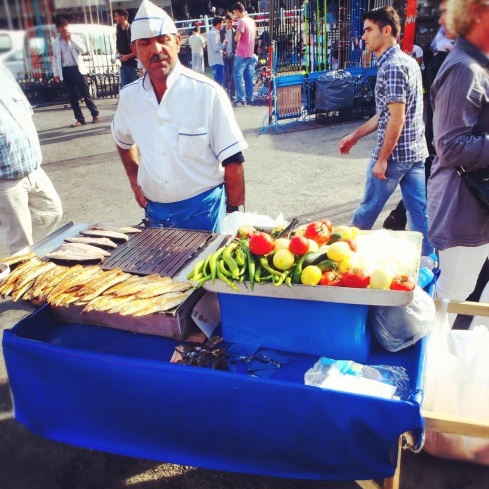
Tobacco seller at Karakoy.
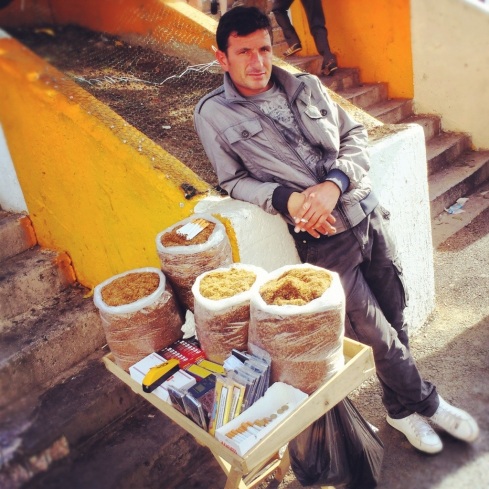
We arrived in Istanbul at probably its busiest time of year, but with a population of 14 million on a regular day I’m guessing it wouldn’t diminish a lot.
Now, I couldn’t finish a blog post without talking about food. All I can say is that I have a huge appreciation for Turkish tea, coffee and cuisine, fast, street and slow. I didn’t even miss bacon… that much.
Turkish tea and coffee.

Neither myself nor Nic tried that dodgy looking wet hamburger (Islak Burger) and I will trust anyone who tells me it is awesome. With no kitchen to use at either hostel, unfortunately (Ha! Not!) we had to eat out a lot. Tavuk (chicken) Shish appeared regularly, served with green pepper, salad, chips and rice. We also ate a ton of chicken kebab meat, but found the best 2 am meal to be the not so authentic Patso. Chips, pide bread, mayo, amazing.
Chicken shish and chicken kebab.

Karniyarik, aubergine stuffed with mincemeat, was my favourite dish from the cafeteria style workers eateries, along with baked beans. But the highlight had to be at Serbethane, this beautifully decorated restaurant inside a 300 year old compound with views of the Blue Mosque in Sultanahmet. We first went for endless cups of Turkish tea with Shisha under the stars and went back for the Testi Kebab. Lamb, chicken and vegetables, cooked over hot coals in a ceramic urn – we were lucky enough to have the restaurant manager bring ours out, still over a flame and smash it open in front of us.
Testi kebab at Serbethane.
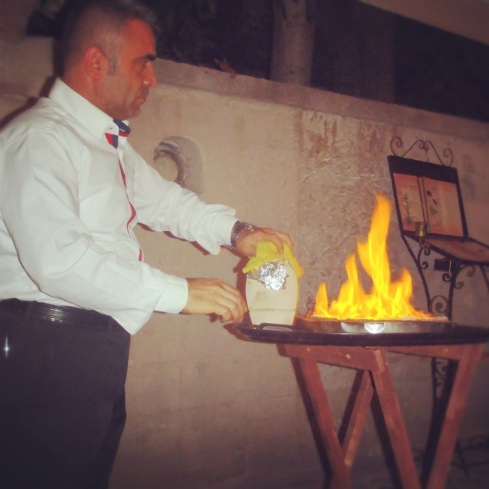
Istanbul deserves a lot longer than the six nights we afforded it and was truly worth every minute of the 22 hour journey it took to reach. Nic even came out of our stay about 5 years younger, thanks to a traditional Turkish cut throat shave and hair cut from the barber on Bogazkesen street!
Cut throat!
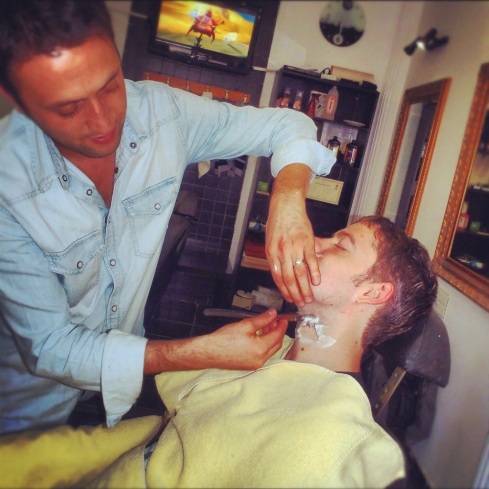
TIME SPENT SO FAR…
In the air – 24.5 hours
Total travelling including flights, buses, airport time – about 148 hours
56.766345
-3.913685
Tags: Australia, Backpacking, bazaar, Beyoglu, Bogazkesen, cats, Eid Al-Adha, Europe, Hostel, Istanbul, Istiklal, live animal export, Perth, Sultanahmet, Taksim, travel, Turkey, Turkish
